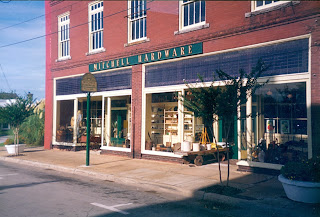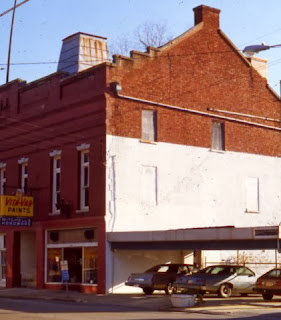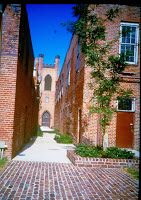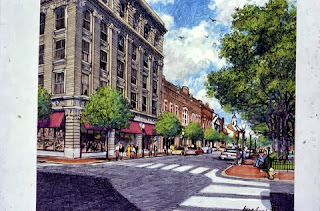 |
| Mitchell Hardware as seen today. |
Snapshot: October 1987 — a typical Saturday morning at the Corner Grill (now the Chelsea), the restaurant filled with people enjoying a leisure breakfast while catching up on the week’s news.
At one particular table the conversation of three locals, Paul Johnson, Stewart Smith and Harold Talton turned to the fate of Mitchell’s Hardware located in the Old City Hall Building on Craven Street.
 |
| The original location of Mitchell Hardware at 220 Craven St. is occupied today by Ballantynes Framing & Art. |
Paul Johnson, Buzz Mitchell’s health is so poor I hear they are going to sell Mitchell’s Hardware. Stewart’s response, Harold, let’s buy it!
On the following Wednesday, October 7, Harold Talton had “closed the deal” and he and his wife Pat were the sole owners of an old-timey hardware store that had been in the Mitchell family for over 90 years.
In a conversation with Harold (Swiss Bear Chairman) I raised the obvious question. Why did a successful businessman, community leader, a regional vice president for First Citizens Bank, recently recognized for 40 years of service, buy, relocate and expand an old-timey store?
Here’s Harold’s reply beginning with a brief history lesson. Mitchell Hardware started out as a livery stable in 1898, which sold in addition to mules and horses, wagons and harnesses. In the early 1900’s they went out of the livery business and got into hardware. To put it more colorfully, they opened the gate, ran the horses and mules off and brought in the hardware.
Within a year’s time, change was in the wind. My original intention was to stay at the location on 220 Craven Street but the space, only 17 feet wide, just wasn’t big enough. The Parker Building just across the street was on the market and I saw the potential.
Harold continued, even before I heard the hardware store was for sale on that Saturday morning over coffee, I knew Greg Smith, a Boy Scout executive for 10 years, was looking to change his life style. Before I made the offer on the building, I talked with Greg. Within a two-week period, Greg was married, had a new job and was in a new town to run and manage the hardware store.
When I turn in my key and Master Card at First Citizens Bank, I hope to spend some time there.
What they attempted to do was recreate a turn-of-the-century hardware store. The fact that Mitchell’s was old-timey is the main reason Harold bought it. He enjoyed going to auctions and estate sales to look for and buy items that would have been sold at the turn-of-the-century. They are used as decorations in the store, but most items are for sale.
When they purchased the S.B. Parker Building, the tin-pressed ceilings were still in-tact. Although many people recommended lowering the ceilings to retain all the fluorescent fixtures that had been hung over the years, he removed and replaced them with lights from that era and three old ceiling paddle fans that were made the same year the building was constructed.
He put in wooden floors and built additional shelving to match the original shelving that was still in the building. The counter is the original counter from the old Mitchell Hardware.
Over the years he continued to add “old” items and merchandise to “add to the customer’s experience”.
The hardware carries a full range of nails, paints, tools, etc., and specialty food items - jams, smoked hams in season, even honey from his own bees.
As a result of a casual conversation one Saturday morning, Mitchell Hardware incorporated as “Hams, Jams, Hardware and Stuff, Inc.” is and continues to be a place where people browse, visit, and explore for no better reason than they just like being there for the pure pleasure of being there.
*Harold Talton was chairman of Swiss Bear for a total of eight years. He passed away in 2008 and Greg bought the business from the Talton family several years later. It was a wise decision on Harold’s part to bring Greg into the business. Greg is an ambassador for downtown and Mitchell Hardware is a destination for visitors and area citizens alike.













